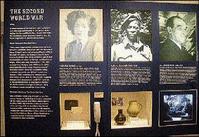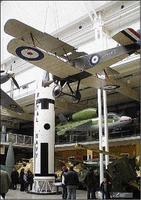
Close-up of interior display on Norma Best from Belize, Jamaican artist Cecil Baugh and Trinidadian musician Al Jennings in the 'From War to Windrush' exhibition at the Imperial War Museum, London, England, through October 2009.
The Imperial War Museum - what a frightening-sounding institution! Yet, there it was, a letter from them requesting information about Cecil Baugh, our highly honoured Jamaican potter, who helped Edna Manley create the original School of Art.
The exhibition staff were delighted to find a West Indian artist and educator who had also served with the Royal Electrical and Mechanical Engineers during World War II. More important, Cecil had been a passenger on the MV Empire Windrush in 1948 when it left Kingston on May 24 for Britain.
That voyage, with 492 West Indian passengers, each paying £28 2 shillings fare, lasted 25 days and deposited the passengers into a country with a black population of only some 15,000 in 1939. Ten years after the Windrush's arrival that population stood at 125,000 West Indians, while today one per cent of Britain's population is of West Indian ancestry. Now this voyage is considered "as the key event in the history of multi-cultural Britain", according to the Imperial War Museum's (IWM) excellent exhibition, 'From War to Windrush'.
Exhibition

Ceiling of main hall at the Imperial War Museum, exploring human experiences of war and wartime life since World War I involving Britain and the Commonwealth.
Opening June 2008, 60 years after the ship's arrival, the exhibition was to have closed by June 2009, but its success is so great that it will continue through October 2009. Make a note because, if you're interested in the West Indies, you will want to visit this exhibition if you can get to London.
I was delighted at how easy it is to find the museum on Lambeth Road, near the Old Vic Theatre, south of the Thames but not far from Elephant and Castle and the South Bank cultural centre. Coaches from Europe park in front of the broad lawn where two 15-inch mounted guns with enormously long muzzles remind us of what warfare once was. Inside, aircraft dangling from a huge domed skylight, as though flying through the sky from World War I, dazzled me.
Good fun
The museum is amazingly good fun for people of all ages and backgrounds. Quite a feat, considering some of the morbid material so movingly presented to the public. It was the Jamaican poet, film writer and novelist Evan Jones who told me how useful the IWM archives were to him while researching his script for King and Country.
Thanks to him, on my second visit I discovered the World War I trenches, recreated in the basement of the IWM, an experience not to be missed! I have yet to venture to the third floor for The Holocaust Exhibition, not recommended for children under 14. And everything is free except special temporary exhibitions such as 'For Your Eyes Only', Ian Fleming and James Bond running until March 1, 2009.
No, I was totally absorbed in 'From War to Windrush', split between two galleries, left and right, with pride of place as you enter the museum. So much information to absorb! Did you know that 16,000 men from the Caribbean volunteered to fight for Britain in World War I, and that "The British West Indies Regiment was formed in 1915 in order to prevent large numbers of black men from the Caribbean serving in British regiments?"
The colour bar prevented them from receiving officers' commissions until in December 1918: "180 soldiers from the British West Indies Regiment led a mutiny at Taranto, Italy, to protest against the colour bar and the denial of a pay rise. One mutineer was executed, others received sentences of between three and five years of imprisonment.
"The resulting disbandment of the regiment prompted many former soldiers to join the growing nationalist and independence movements in the Caribbean," according to exhibition notes.
Used by many schools in the UK and Europe, the museum carefully measures a mixture of cruel truth with inspirational truth so that the visitor is momentarily aghast, momentarily exhilarated. Really, the exhibition staff spent more than a year carefully researching this material to make it memorable to the max. And don't miss their bookstore. Baugh: Jamaica's Master Potter is now available there, along with other great books, posters and postcards.
Another wall scroll lists the West Indian contributions to WWI, with Jamaica sending 300,000 Jamaican cigarettes as well as oranges for hospitals! Brilliantly coloured posters highlight the WWII effort, while cultural icons are not forgotten. Ten thousand West Indians signed up to fight for Britain in World War II, this time with West Indian women allowed to join, in 1942.
An extract of Louise Bennett's poetry about Gibraltar Camp at Mona is there, while next to Baugh's photo in uniform, one of only 17 Windrush passengers to be highlighted with a backlit photo, above examples of his pottery, is a photo of Namba Roy, the brilliant Maroon artist, with an actual painting by him on display, thanks to Anne Walmsley.
Meanwhile, the music of Trinidadian Al Jennings' band is playing on a video clip. In the other gallery 'Lord Kitchener' from Trinidad is being interviewed and sings about "Citizens of the Empire coming to the Mother Country to find work." So many stories to learn from, with faces and voices of West Indians making history come alive, ensuring that this is an exhibition to linger over. Maybe even an exhibition we could lure to our museum here one day.
Dr Harold Moody, born in Kingston in 1882, who founded The League of Coloured Peoples, had five of his six children serve as officers in the Army and Royal Air Force in WWII. Colonel Charles Arundel Moody, born in Britain in 1917, became the first black officer in the British Army in WWII.
Valuable
William Robinson Clarke, born in Jamaica 1895, was one of the few West Indian pilots to serve in WWI. Allan Wilmot, Sam King, Connie Mark -so many Jamaicans in the exhibition! While Learie Constantine, born in Trinidad, served as a Cabinet member in the Trinidadian government, became TT's first High Commissioner to Great Britain in 1961 and became the first black Life Peer in the UK. From Belize, Guyana, St Vincent, on and on the exhibition acquaints us with West Indians of valour, valuable to Caribbean culture. 'From War to Windrush', experience it if you can. www.iwm.org.uk/windrush. Open daily 10 to 6 (closed 24-26 December) Tel: 020 7416 5000.